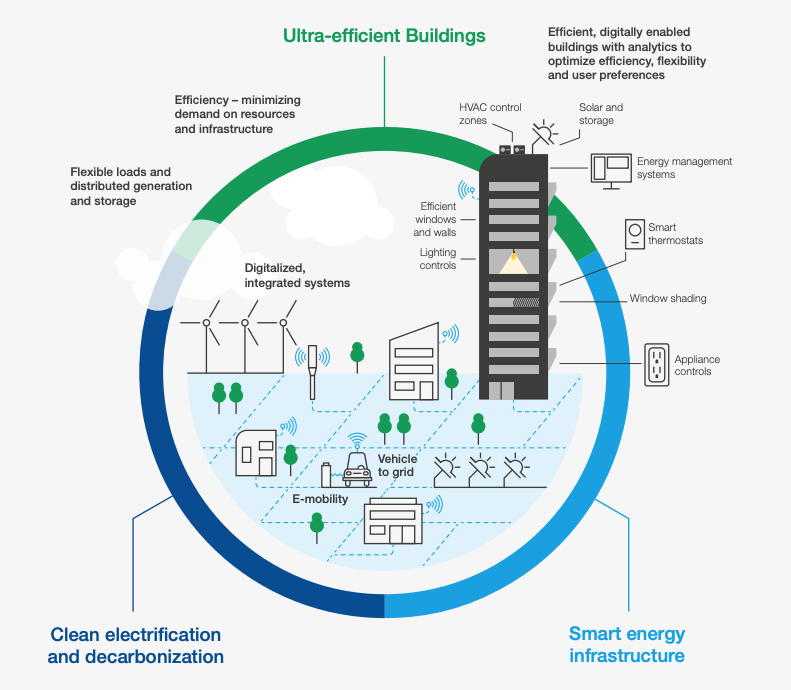Have we reached peak fossil fuel? These charts show how 2023 could be a new era for power

More than 40% of carbon dioxide (CO2) emissions are the result of burning fossil fuels for power generation. Image: Pexels/Ricky Esquivel

Get involved with our crowdsourced digital platform to deliver impact at scale
Stay up to date:
Energy Transition
Listen to the article
- We are approaching “the beginning of the end of the fossil age”, according to the fourth annual Global Electricity Review from energy think tank Ember.
- 2023 could be the year that renewable power reaches a tipping point where power-generation emissions begin to fall.
- These charts show how renewables will replace fossil fuels, and which regions are leading the way in decarbonization.
Power generation could soon be approaching “the beginning of the end of the fossil age”, according to the fourth annual Global Electricity Review from energy think tank Ember.
Could this be the year that renewable power generation reaches a tipping point – where power generation emissions begin to fall? The report’s findings show the huge potential of decarbonizing the electricity sector, since more than 40% of carbon dioxide (CO2) emissions are the result of burning fossil fuels for power generation.
The following charts from the report show how and when renewables will replace fossil fuels in power generation, and which regions are leading the way in decarbonization.
Wind and solar: the renewable transition

The above chart shows historical levels of annual electricity generation, as well as projections for 2023-2026, and illustrates the significant advances in wind and solar power generation investment during recent years. Projections make 2023 the year when emissions should finally start to fall, mainly the result of a continuation of solar and wind power growth.
Wind and solar power generation is growing by around 15-20% per year – based on a 10-year average – and looks set to outstrip any increases in annual electricity demand by the end of 2023 as they are, in many countries, already cheaper and strategically more secure than fossil fuels.
Other non-fossil fuels are also generating more power, although hydro and nuclear power increases have been less steady, affected by unusual weather patterns.
What is the Forum doing to help cities to reach a net-zero carbon future?
Power generation needs to decarbonize by 2040
Many sectors are targeting 2050 as the deadline for net zero emissions under the International Energy Agency’s (IEA) Net Zero Emissions (NZE) scenario. But the global power sector is the biggest emitter overall, and needs to be decarbonized by 2040 to allow renewable power generation to help accelerate other sectors to net zero, according to the report.

This chart shows the scale of the changes that power generation will undergo in the IEA’s net-zero scenario. Coal and gas power will be phased out in the coming years, replaced primarily by solar and wind power because of their relatively low cost and quick installation potential. This would take the power sector from the biggest CO2 emitter in the world to zero CO2 emissions in 17 years.
The changing shape of the global power mix

This chart shows the decline of electricity generated from oil, coal and gas, as clean power sources take increasingly higher percentages of the overall mix. Wind and solar power provide 75% of the increase in clean power from now to 2050 in the IEA scenario. But nuclear power, hydro, fossil fuels with carbon capture, utilization and storage (CCUS) and other renewables will all play vital roles too.
Which regions lead the way on renewables?
Everyone is on the same journey to decarbonize, but some regions may take longer to get there. Europe began its shift to decarbonization first, so led the regions for many years. However, Oceania’s share of power generation from solar and wind has recently overtaken Europe on the back of rapid growth in Australia. Meanwhile, Asia, which started later, is catching up fast.
Asia is accelerating fast as three of the world’s top-five absolute generators of wind and solar are in Asia: China, Japan and India. But other countries in the region are just beginning their journeys, and are offsetting the overall success of Asia’s transition to renewables.
China has increased the number of solar panels on rooftops through a three-year policy that started in 2021. Known as Whole-Country Rooftop Solar, it contributed to China being responsible for around a fifth of all solar-panel installations in 2022.
The success of policy-led investment in China aligns with the goals of the World Economic Forum’s Global Future Council on Clean Electrification. Its latest Insight Report invites policymakers, regulators and investors to place greater focus on the demand side of the electricity system.
Ember's findings demonstrate the global success of early policies and investments in renewable energy to date. With more investment in renewables every year, its growing share of the power-generation mix could see emissions start to fall, according to the lead author of the Global Electricity Review, Małgorzata Wiatros-Motyka.
“Clean electricity will reshape the global economy, from transport to industry and beyond. A new era of falling fossil emissions means the coal-power phasedown will happen, and the end of gas-power growth is now within sight. Change is coming fast. However, it all depends on the actions taken now by governments, businesses and citizens to put the world on a pathway to clean power by 2040.”
Don't miss any update on this topic
Create a free account and access your personalized content collection with our latest publications and analyses.
License and Republishing
World Economic Forum articles may be republished in accordance with the Creative Commons Attribution-NonCommercial-NoDerivatives 4.0 International Public License, and in accordance with our Terms of Use.
The views expressed in this article are those of the author alone and not the World Economic Forum.
Related topics:
The Agenda Weekly
A weekly update of the most important issues driving the global agenda
You can unsubscribe at any time using the link in our emails. For more details, review our privacy policy.
More on Energy TransitionSee all
Katie Fedosenko and Luciana Gutmann
April 15, 2024
Johnny Wood
April 11, 2024
Alexandre Raffoul and Kai Keller
April 10, 2024
Roberto Bocca
April 10, 2024
Naoko Tochibayashi and Naoko Kutty
April 10, 2024
Linda Lacina
April 5, 2024








